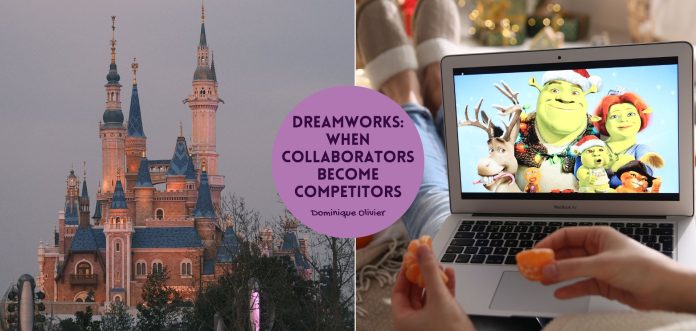When you sideline a rainmaker, you can’t act surprised when they start making it rain somewhere else. This is the story of how one botched promotion led to the creation of a real thorn in Disney’s side – and set a whole new direction for the animation industry.
I would be remiss if I wrote one more sentence in this article without quoting that famous adage that we’ve all heard before: if you don’t build your own dreams, someone else will pay you to build theirs.
There’s a particular kind of corporate drama that only Hollywood can deliver – the kind with billion-dollar stakes, fragile egos, and enough behind-the-scenes beef to season a thousand Succession scripts. But this story isn’t fiction. It’s the very real tale of how Jeffrey Katzenberg, Disney’s comeback conductor, helped revive a dying studio… only to be shown the door, team up with Spielberg, and build the first real threat to the House of Mouse since Walt himself wore the crown.
The Katzenberg era: the resuscitation of a mouse
In 1984, Disney was floundering. At the box office, it was dead last among major studios. Animation was clunky. The live-action offerings were tepid. The house that Mickey built was on the verge of becoming irrelevant. It was time for a change in management, and fast. Enter Michael Eisner as CEO, and alongside him, Jeffrey Katzenberg as Chairman of Walt Disney Studios.
Katzenberg had been poached from Paramount, where he’d already built up a reputation as a no-nonsense, hands-on executive with a knack for spotting hits (he’d overseen Indiana Jones and the Temple of Doom and Terms of Endearment, to name just two). At Disney, he rolled up his sleeves and got right to work, much to the chagrin of a few animators, who weren’t accustomed to the c-suite getting so closely involved in their work. Katzenberg famously cut scenes from work-in-progress The Black Cauldron himself because he thought the film was bloated. This early butting-of-heads really set the tone for the rest of Katzenberg’s career at Disney: he may not have been well-liked, but he sure got things done.
He revived Disney’s animation division like it was his own pet project. And to be fair, it sort of was. Under his watch came the so-called “Disney Renaissance”, a string of hits that would put the embattled studio back at the top of the box office: The Little Mermaid, Aladdin, Beauty and the Beast, and The Lion King. These weren’t just crowd-pleasers – they were industry-defining films. Beauty and the Beast even landed a Best Picture Oscar nod, the first time in history that an animated film was nominated. But Katzenberg didn’t stop at singing crabs and enchanted teapots. He launched Touchstone Pictures, which churned out megahits for grown-ups (think Pretty Woman, Dead Poets Society, Good Morning Vietnam). Under his steer, Disney stopped being a nostalgic relic and started being cool again. You’d think the guy would be up for a corner office and a serious pay bump.
Unfortunately, that’s not how things panned out.
Trouble in paradise
By the mid-90s, Disney had transformed from an industry afterthought to an unstoppable creative engine. Internally, though, things were starting to crack.
Success is a funny thing. It makes people rich, yes, but it also makes people nervous. And when too much credit starts flowing toward one person, the rest of the boardroom gets twitchy. Behind the scenes, Katzenberg was clashing with both Eisner and Roy E. Disney (Walt’s nephew and board member). There were whispers that he was taking too much credit. That he was too ambitious. That he had presidential aspirations, not of the political kind, but of the corporate throne. He wanted the number two job at Disney.
When Disney president Frank Wells died in a helicopter crash in 1994, Katzenberg assumed he’d get the nod. Eisner disagreed. According to Katzenberg, Eisner had promised the job. According to Eisner, there were complications – namely, Roy Disney threatening a board revolt if Katzenberg moved up the chain.
Instead of a promotion, Katzenberg got the boot. Well, technically, his contract ended and wasn’t renewed. But by all accounts, it was clear: there was no longer room for him at the table.
Fine, I’ll build my own kingdom
Most people would lick their wounds. Maybe write a memoir. Not Katzenberg.
Within months, he was on the phone with Steven Spielberg and David Geffen. The result was DreamWorks SKG, a shiny new studio built from scratch, with Katzenberg running the animation division like it was his personal revenge tour.
DreamWorks would go on to roll out box office hits The Prince of Egypt, Shark Tale, Kung Fu Panda, and How to Train Your Dragon. But the real line in the sand came in the form of a flatulent ogre named Shrek – a movie that took direct aim at Disney’s fairytale formula, cast a villain suspiciously reminiscent of Michael Eisner, and snatched the first-ever Oscar for Best Animated Feature from right under the Mouse’s nose.
Shrek wasn’t just a box office smash. It was a cultural reset. It proved there was room for a different kind of animation – funnier, messier, more meta. Less hand-drawn, more CGI. DreamWorks had officially arrived. Katzenberg looked at the success of CGI films like Shrek versus the relatively tepid response to DreamWorks’ traditional animated films like Sinbad and Spirit and deduced that it was time to leave the sketchpads behind and embrace computer animation in full. This instinct would ultimately position DreamWorks ahead of the pack by the time rival CGI-only studios like Illumination reared their heads.
Meanwhile, Disney was navigating a rocky path, with internal spats, lukewarm releases, and a growing reliance on Pixar to keep the magic alive.
Talent lost is opportunity gained (for someone else)
What can businesses learn from all this? One thing: if you don’t nurture your best people, someone else will.
Jeffrey Katzenberg transformed Disney from a dusty relic into a cultural force. But rather than reward or retain him, the company let office politics win. In doing so, they didn’t just lose an exec, they created a rival with a mouse-shaped axe to grind. Talent like Katzenberg’s doesn’t just disappear when you push it out. It gets resourceful. It finds new playgrounds. Sometimes it even builds its own castle down the road, draws a moat, and starts launching catapults.
To be clear: not every star employee should get a blank cheque. And not every risk pans out. But the cost of letting talent walk away – especially when that talent is reshaping your industry – can be far greater than the cost of keeping them engaged, empowered, and maybe even a little ambitious.
Because if there’s one thing Katzenberg proved, it’s that nothing motivates a visionary quite like being underestimated.
About the author: Dominique Olivier

Dominique Olivier is the founder of human.writer, where she uses her love of storytelling and ideation to help brands solve problems.
She is a weekly columnist in Ghost Mail and collaborates with The Finance Ghost on Ghost Mail Weekender, a Sunday publication designed to help you be more interesting. She now also writes a regular column for Daily Maverick.
Dominique can be reached on LinkedIn here.





Great read!
Thanks so much Craig, I’m glad you enjoyed it!
Most interesting and well put together.